Tags
anthropomorphism, Bestiaries, heraldry, La Fontaine, mythical animals, mythological animals, symbols and emblems, the Griffin, The Physiologus, zoomorphism
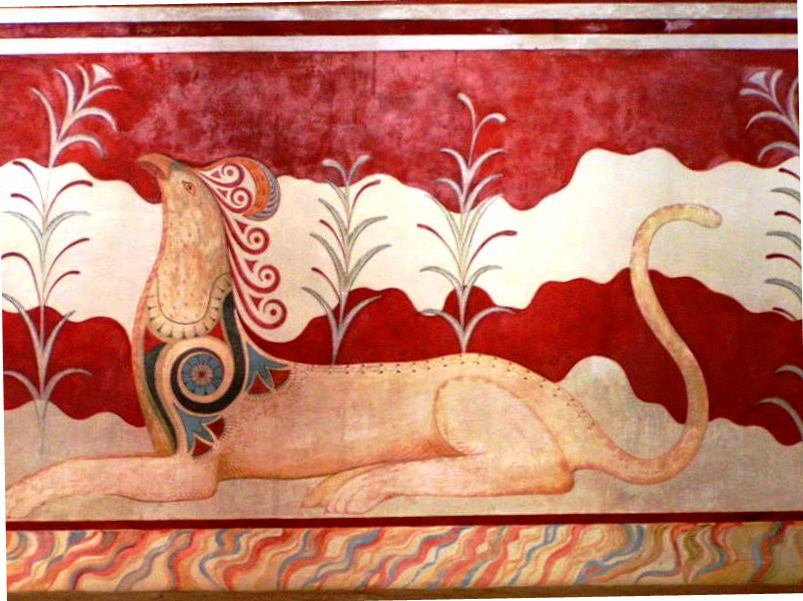
Griffin fresco in the “Throne Room,” Palace of Knossos, Crete, Bronze Age.
(Photo credit: Wikipedia)
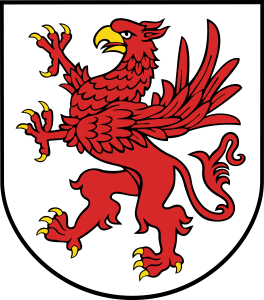 The Griffin
The Griffin
The red Griffin “rampant” (crawling) was the coat of arms of the dukes of Pomerania and survives today as the armorial of West Pomeranian Voivodeship (historically, Farther Pomerania) in Poland. (Photo credit: Wikipedia)
When the griffin or other mythical/mythological animal is featured on a crest in a climbing position, he is called “rampant.”
Anthropomorphism
- Æsopic, Libystic and Sybaritic fables
Anthropomorphism was defined in my post on Vaux-le-Vicomte. Moreover, Milo Winter’s illustrations for “The North Wind and the Sun” provide examples of elements disguised as human beings. Fabulist Jean de La Fontaine used anthropomorphism: animals, elements, vegetation, mountains. In some fables, he featured humans and who were viewed as morally inferior to animals. The Man and the Snake (The Man and the Adder or L’Homme et la Couleuvre [X.1]) is an example of the use of an inferior human being in a fable. Fables featuring beasts only are called Æsopic. Those featuring human beings interacting with beasts are called libystic, and those featuring humans only are sybaritic fables.[I]
The Use of Anthropomorphism
- a fox is a fox is a fox
The word Æsopian refers to a language that can only be understood by people other than insiders. Nineteenth-century Russian satirist Mikhail Yevgrafovich Saltykov-Shchedri was the first to use the term æsopian language. Animals speak and do no speak. In the end, as eloquent as he may be, a fox is a fox is a fox. Gertrude Stein’s “a rose is a rose is a rose” captured the spirit of anthropomorphism. Whether they are used as a carpe diem or a memento mori, roses are roses are roses.
In 1997, in his review of Marc Fumaroli‘s Le Poète et le Roi, Jean de La Fontaine en son temps, Charles Rosen wrote that “[w]ith La Fontaine’s Fables, we do not have to burrow far under the surface to recognize a discreet opposition to the grandeur of style and the servile obedience wanted by the court, an opposition never openly expressed but manifest on every page.” (The New York Review of Books, “The Fabulous La Fontaine,” (18 December 1997.)[II] Fables feature speaking animals, but readers know that animals do not speak just as Louis knows he is not a lion. Therein lies the wizardry of beast fables.
Animals as Types
In the preface to his translation of Aesop’s fable, Townsend writes that
“The Fox should be always cunning, the Hare timid, the Lion bold, the Wolf cruel, the Bull strong, the Horse proud, and the Ass patient” and all of this, “by mutual consent.”
http://www.gutenberg.org/files/21/21-h/21-h.htm#link2H_PREF

Zoomorphism: Hybrid Anthropomorphic Creatures
However, certain legendary or mythical animals as well as mythological animals are hybrid creatures who combine the features of humans and those of an animal or combine the features of several animals. Zoomorphic animals are also anthropomorphic, or humans in disguise.
Well-known animals that combine human and animal features are centaurs and the Minotaur. Centaurs have the torso of a man or a woman, but their lower body is that of a horse. The Minotaur, he is the son of Pasiphaë and a bull. He is therefore a hybrid animal that is kept in a labyrinth built by Dædalus. The Minotaur is slain by Theseus who finds his way through the labyrinth using Ariadne‘s thread. Theseus also slays a centaur. Zoomorphic animals may belong to a mythology, in which case they have lineage and ancestors. Interestingly, angels have wings, but they are otherwise identical to human beings.
Usually, mythologies tell a story that explains origins. They are etiological narratives. In children’s literature, etiological narratives are called “pourquoi” (why) stories. Rudyard Kipling‘s Just So Stories (1902) are “pourquoi” narratives. However, some legendary creatures, such as the phoenix, appear to straddle both categories, the mythical and the mythological. The distinguishing factor could be the degree of symbolism attributed to the animal. The more symbolic the animal, the more mythical. By and large, mythical animals are zoomorphic and have no lineage. Relatively few are not featured in etiological narratives, such as the Bible and and many inhabit the medieval bestiary. Bestiaries are allegorical.
Zoomorphic Beasts
The dragon, the griffin, and the unicorn are zoomorphic animals combining the features of many animals. They are legendary or mythical animals, rather than mythological beasts. However, both the griffin and the phoenix do belong to certain mythologies. It may be legitimate to separate the dragon, the griffin, the phoenix and the unicorn from other zoomorphic animals in that all four are likely to appear as symbols, but so do other legendary animals. The phoenix, who rises from his own ashes, is a symbol of rebirth. The unicorn appears in the Bible, but he is not listed in Donald Ray Schwartz’s Noah’s Ark, the Hebrew Bible.[III] The Western unicorn cannot be captured by a person other than a virgin. He is therefore emblematic of chaste love. In children’s literature, he is often described as an animal who missed the boat: Noah’s Ark. (See Unicorn, Wikipedia.)
- The dragon‘s characteristics change from culture to culture. He is feared in the West, but not in China.
- The griffin, shown at the top of this post, a lion mostly, with the head of an eagle, is a guardian. In antiquity, he was a symbol of divine power and a guardian of the divine.
- The unicorn has one horn and plays various roles from culture to culture. In Western culture, he is, as mentioned above, “emblematic of chaste love and faithful marriage.”
- Given that he rises from his own ashes, the phoenix is a symbol of rebirth and very popular.
 The Order of the Dragon was created to defend Europe against the invading Ottoman Turks in the 15th century. (Photo credit: Wikipedia)
The Order of the Dragon was created to defend Europe against the invading Ottoman Turks in the 15th century. (Photo credit: Wikipedia) 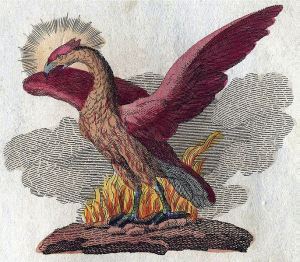 A phoenix depicted in a book of mythological creatures by F. J. Bertuch (1747-1822).(Photo credit: Wikipedia)
A phoenix depicted in a book of mythological creatures by F. J. Bertuch (1747-1822).(Photo credit: Wikipedia)
Other Zoomorphic Animals
Other relatively well-known zoomorphic animals, combining animal features only, are Pegasus, the winged horse of Greek mythology, or Cerberus/Kerberos, the three-headed dog who guards the entrance to the underworld. In The Tale of Cupid and Psyche, Psyche is told how to avoid him, which enables her to fetch beauty from Persephone without dying. Locksmiths and businesses that provide alarm systems often name their store or company Cerberus/Kerberos.
There are medieval love bestiaries, such as Richard de Fournival‘s Bestiaire d’amour (ms 12469 Bibliothèque nationale de France). In medieval bestiary, animals are used allegorically. In fact, animals inhabiting medieval bestiaries are allegorical figures and they are usually the same from author to author. They are as described by Pliny the Elder (23 CE – 25 August 79 CE), Isidore of Seville, etc. or as described in the 2nd century CE Physiologus. (See Physiologus, Wikipedia.) However, the unicorn and the griffin are often featured on coats of arms, shields, helmets, and blazons in heraldry. (See Zoomorphism, Wikipedia.)
High Fantasy Literary Works and other Literary Works
The phoenix appears in J. K. Rowling‘s Harry Potter and the Order of the Phoenix (2003), in which we also find the griffin Albus Dumbledore. As well, the Harry Potter series features Cerberus/Kerberos. The griffin, however, had been used previously. For instance, he appears in Dante Alighieri‘s (c. 1265–1321) Divine Comedy and in John Milton‘s Paradise Lost. In C. S. Lewis‘ popular Chronicles of Narnia, we find a centaur.
They are also featured in children’s literature. Kenneth Grahame’s The Wind in the Willows is a children’s novel, but such works are best understood by adults if poorly illustrated.
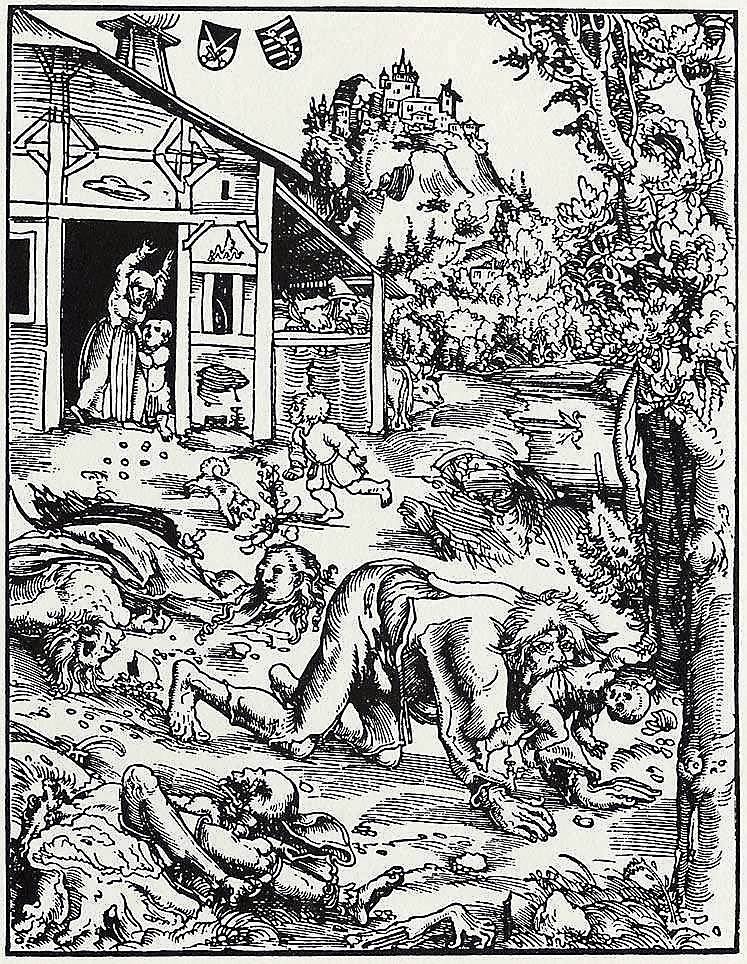
Werewolf by Lucas Cranach the Elder (Gotha, Herzoglishes Museum)
Other Roles
- metamorphosis
- the werewolf, le loup garou
- animal ancestry
Therianthropic animals, humans that transform themselves into beast and vice versa can be looked upon as zoomorphic creatures. There are therianthropic beings in fairy tales, which is usually the result of a curse. A fine example is Beauty and the Beast. Enchantment is central to fairy tales. But shapeshifting animals bring to mind the werewolf (le loup-garou), a lycanthrope, rather than fairy tales.
Beast literature is not an animal counterpart of fairy-tales.
The above shows, among other factors, to what extent humans see commonality with animals, but not as in Darwinism.
_________________________ [I] Jan M. Ziolkowski, Talking Animals: Medieval Latin Beast Poetry, 750 – 1150 (The University of Pennsylvania Press, 1993), p. 18.[II] Marc Fumaroli, Le Poète et le Roi, Jean de La Fontaine en son siècle (Éditions de Fallois, 1997).[III] Donald Ray Schwartz, Noah’s Ark, an Annotated Encyclopedia of every Animal Species in the Hebrew Bible (Jason Aron Inc.: Northvale, New Jersey, Jerusalem, 2000).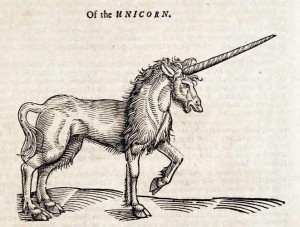
Camille Saint-Saëns (9 October 1835 – 16 December 1921)
Le Carnaval des animauxThe Yale, The Bern Physiologus
© Micheline Walker
25 August 2013
WordPress

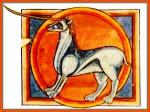

No one can deny from the feature of this video posted at this web site, nice work, keep it all the time.
LikeLike
Downloading material from this site is as effortless |as clicking the mouse rather than other blogs which move me here and there on the web pages.
LikeLike
Those are reassuring comments.
Many thanks,
Micheline
LikeLike